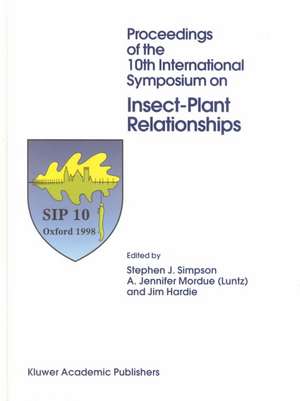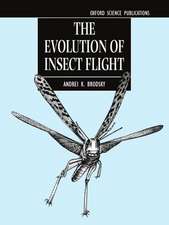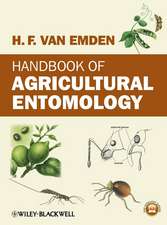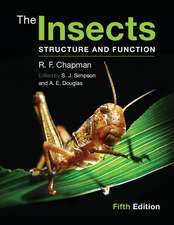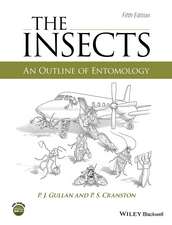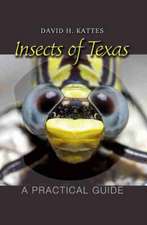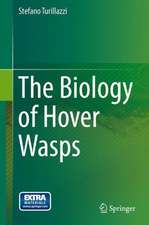Proceedings of the 10th International Symposium on Insect-Plant Relationships: Series Entomologica, cartea 56
Editat de Stephen J. Simpson, A. Jennifer Mordue, Jim Hardieen Limba Engleză Hardback – 30 sep 1999
| Toate formatele și edițiile | Preț | Express |
|---|---|---|
| Paperback (1) | 946.69 lei 6-8 săpt. | |
| SPRINGER NETHERLANDS – 28 ian 2011 | 946.69 lei 6-8 săpt. | |
| Hardback (1) | 950.96 lei 6-8 săpt. | |
| SPRINGER NETHERLANDS – 30 sep 1999 | 950.96 lei 6-8 săpt. |
Din seria Series Entomologica
-
 Preț: 393.90 lei
Preț: 393.90 lei -
 Preț: 385.25 lei
Preț: 385.25 lei -
 Preț: 414.42 lei
Preț: 414.42 lei -
 Preț: 393.90 lei
Preț: 393.90 lei - 18%
 Preț: 830.70 lei
Preț: 830.70 lei - 18%
 Preț: 1220.75 lei
Preț: 1220.75 lei - 18%
 Preț: 1841.32 lei
Preț: 1841.32 lei - 18%
 Preț: 1218.04 lei
Preț: 1218.04 lei - 18%
 Preț: 1223.25 lei
Preț: 1223.25 lei -
 Preț: 385.62 lei
Preț: 385.62 lei - 24%
 Preț: 811.86 lei
Preț: 811.86 lei -
 Preț: 351.51 lei
Preț: 351.51 lei - 18%
 Preț: 810.99 lei
Preț: 810.99 lei -
 Preț: 403.53 lei
Preț: 403.53 lei - 18%
 Preț: 936.93 lei
Preț: 936.93 lei - 15%
 Preț: 642.83 lei
Preț: 642.83 lei -
 Preț: 393.59 lei
Preț: 393.59 lei - 18%
 Preț: 1664.26 lei
Preț: 1664.26 lei - 18%
 Preț: 1217.27 lei
Preț: 1217.27 lei - 18%
 Preț: 1386.30 lei
Preț: 1386.30 lei - 18%
 Preț: 1831.27 lei
Preț: 1831.27 lei - 18%
 Preț: 951.14 lei
Preț: 951.14 lei - 18%
 Preț: 2107.18 lei
Preț: 2107.18 lei - 18%
 Preț: 1219.77 lei
Preț: 1219.77 lei - 18%
 Preț: 1832.22 lei
Preț: 1832.22 lei - 18%
 Preț: 1229.91 lei
Preț: 1229.91 lei - 18%
 Preț: 1594.64 lei
Preț: 1594.64 lei - 18%
 Preț: 1833.16 lei
Preț: 1833.16 lei - 18%
 Preț: 1392.95 lei
Preț: 1392.95 lei - 18%
 Preț: 1237.93 lei
Preț: 1237.93 lei - 18%
 Preț: 1219.31 lei
Preț: 1219.31 lei - 24%
 Preț: 1073.70 lei
Preț: 1073.70 lei -
 Preț: 389.70 lei
Preț: 389.70 lei - 18%
 Preț: 1246.15 lei
Preț: 1246.15 lei - 18%
 Preț: 1226.70 lei
Preț: 1226.70 lei - 18%
 Preț: 1225.31 lei
Preț: 1225.31 lei - 18%
 Preț: 1232.89 lei
Preț: 1232.89 lei - 18%
 Preț: 1832.22 lei
Preț: 1832.22 lei - 18%
 Preț: 1232.71 lei
Preț: 1232.71 lei - 24%
 Preț: 1604.87 lei
Preț: 1604.87 lei
Preț: 950.96 lei
Preț vechi: 1159.71 lei
-18% Nou
Puncte Express: 1426
Preț estimativ în valută:
181.98€ • 188.02$ • 151.38£
181.98€ • 188.02$ • 151.38£
Carte tipărită la comandă
Livrare economică 19 martie-02 aprilie
Preluare comenzi: 021 569.72.76
Specificații
ISBN-13: 9780792357735
ISBN-10: 0792357736
Pagini: 290
Ilustrații: VIII, 290 p.
Dimensiuni: 210 x 279 x 18 mm
Greutate: 0.6 kg
Ediția:1999
Editura: SPRINGER NETHERLANDS
Colecția Springer
Seria Series Entomologica
Locul publicării:Dordrecht, Netherlands
ISBN-10: 0792357736
Pagini: 290
Ilustrații: VIII, 290 p.
Dimensiuni: 210 x 279 x 18 mm
Greutate: 0.6 kg
Ediția:1999
Editura: SPRINGER NETHERLANDS
Colecția Springer
Seria Series Entomologica
Locul publicării:Dordrecht, Netherlands
Public țintă
ResearchCuprins
Opening address.- Insects and plants: two worlds come together.- Central neural bases of host plant recognition.- Dynamic representation of odours by oscillating neural assemblies.- Chemo-discriminatory neurones in the sub-oesophageal ganglion of Locusta migratoria.- Chemosensory bases of host plant recognition.- Specialist deterrent chemoreceptors enable Pieris caterpillars to discriminate between chemically different deterrents.- Olfactory responses and sensilla morphology of the blackcurrant leaf midge Dasineura tetensi.- Experience-based food consumption by larvae of Pieris rapae: addiction to glucosinolates?.- Role of visual cues and interaction with host odour during the host-finding behaviour of the cabbage moth.- Integrative studies of insect behaviour.- Integrating nutrition: a geometrical approach.- Absence of food-aversion learning by a polyphagous scarab, Popilliajaponica, following intoxication by geranium, Pelargonium × hortorum.- Examining the hierarchy threshold model in a no-choice feeding assay.- Anomalous stylet punctures of phloem sieve elements by aphids.- Acceptability of different species of Brassicaceae as hosts for the cabbage aphid.- Salivation into sieve elements in relation to plant chemistry: the case of the aphid Sitobion fragariae and the wheat Triticum aestivum.- Aphid responses to non-host epiculticular lipids.- Effects of Brassica oleracea waxblooms on predation and attachment by Hippodamia convergens.- Insect behaviour in tritrophic systems.- Are herbivore-induced plant volatiles reliable indicators of herbivore identity to foraging carnivorous arthropods?.- Active defence of herbivorous hosts against parasitism: adult parasitoid mortality risk involved in attacking a concealed stemboring host.- Induction of cotton extrafloral nectarproduction in response to herbivory does not require a herbivore-specific elicitor.- Flowers in tri-trophic systems: mechanisms allowing selective exploitation by insect natural enemies for conservation biological control.- Plant defences.- Wound-induced increases in the glucosinolate content of oilseed rape and their effect on subsequent herbivory by a crucifer specialist.- Pyrrolizidine alkaloid distribution in Senecio jacobaea rosettes minimises losses to generalist feeding.- Insect life histories and plant growth responses.- The population ecology of Amorbus Dallas (Hemiptera: Coreidae) species in Australia.- A galling aphid furnishes its home with a built-in pipeline to the host food supply.- Choosing host plants: mechanism and evolution.- Vive la variance: a functional oviposition theory for insect herbivores.- Microbial partners in insect-plant associations.- The assimilation and allocation of nutrients by symbiotic and aposymbiotic pea aphids, Acyrthosiphon pisum.- How nutritionally imbalanced is phloem sap for aphids?.- Genetic bases of host plant associations.- It’s about time: the evidence for host plant-mediated selection in the apple maggot fly, Rhagoletis pomonella, and its implications for fitness trade-offs in phytophagous insects.- Behavioural correlates of genetic divergence due to host specialization in the pea aphid, Acyrthosiphon pisum.- Using hybrid and backcross larvae of Papilio Canadensis and Papilio glaucus to detect induced photochemical resistance in hybrid poplar trees experimentally defoliated by gypsy moths.- Ostrinia spp. in Japan: their host plants and sex pheromones.- Genetic basis for established and novel host plant use in a herbivorous ladybird beetle, Epilachna vigintioctomaculata.- Host-plant choice and larval growth in thecinnabar moth: do pyrrolizidine alkaloids play a role?.- Conclusion.- It’s all in the neurones.- Index of authors.- General index.- Listing of oral and poster presentations from SIP10.- List of registered participants.
